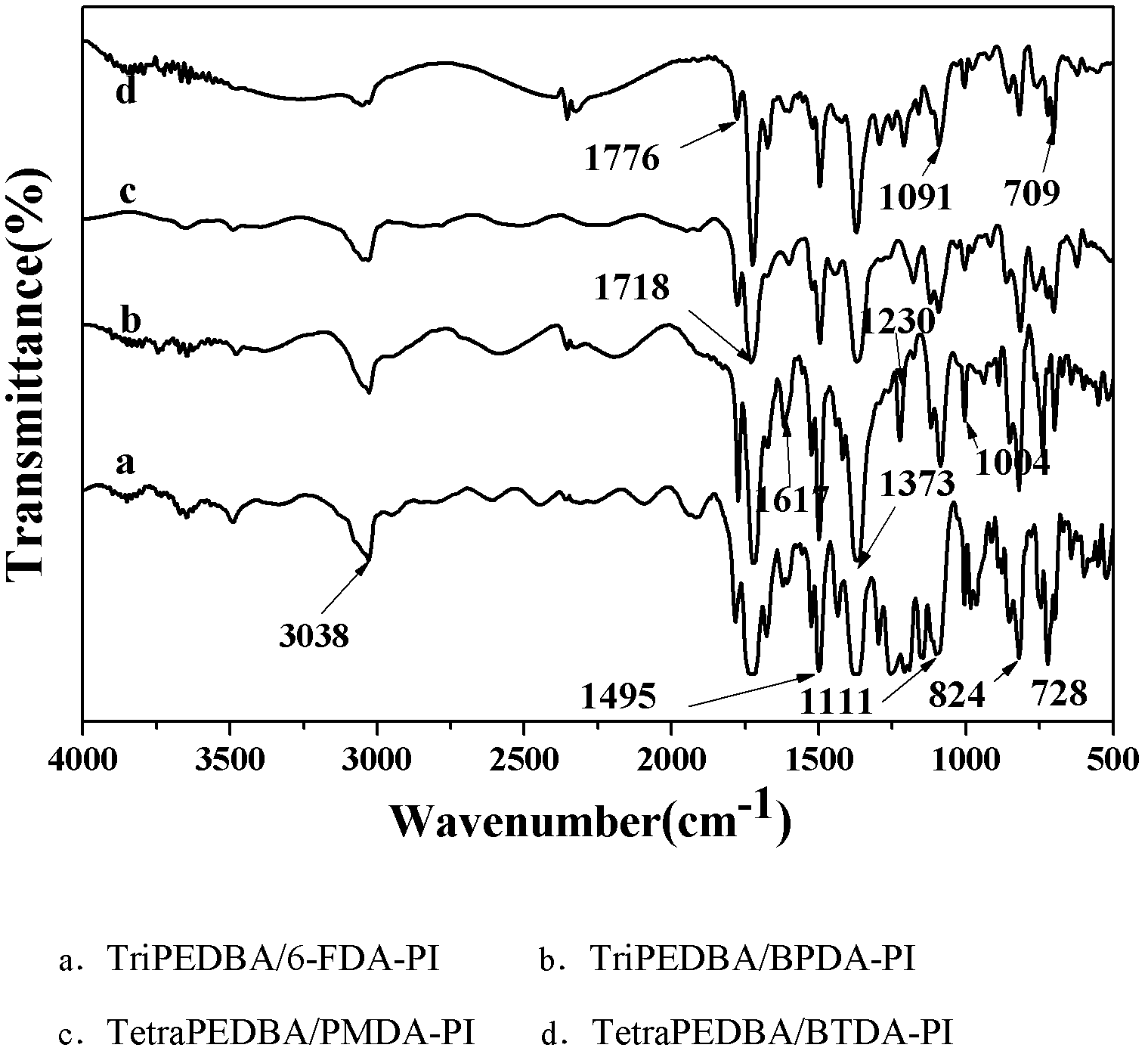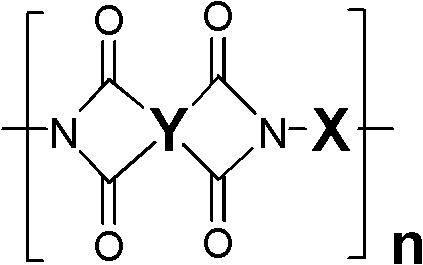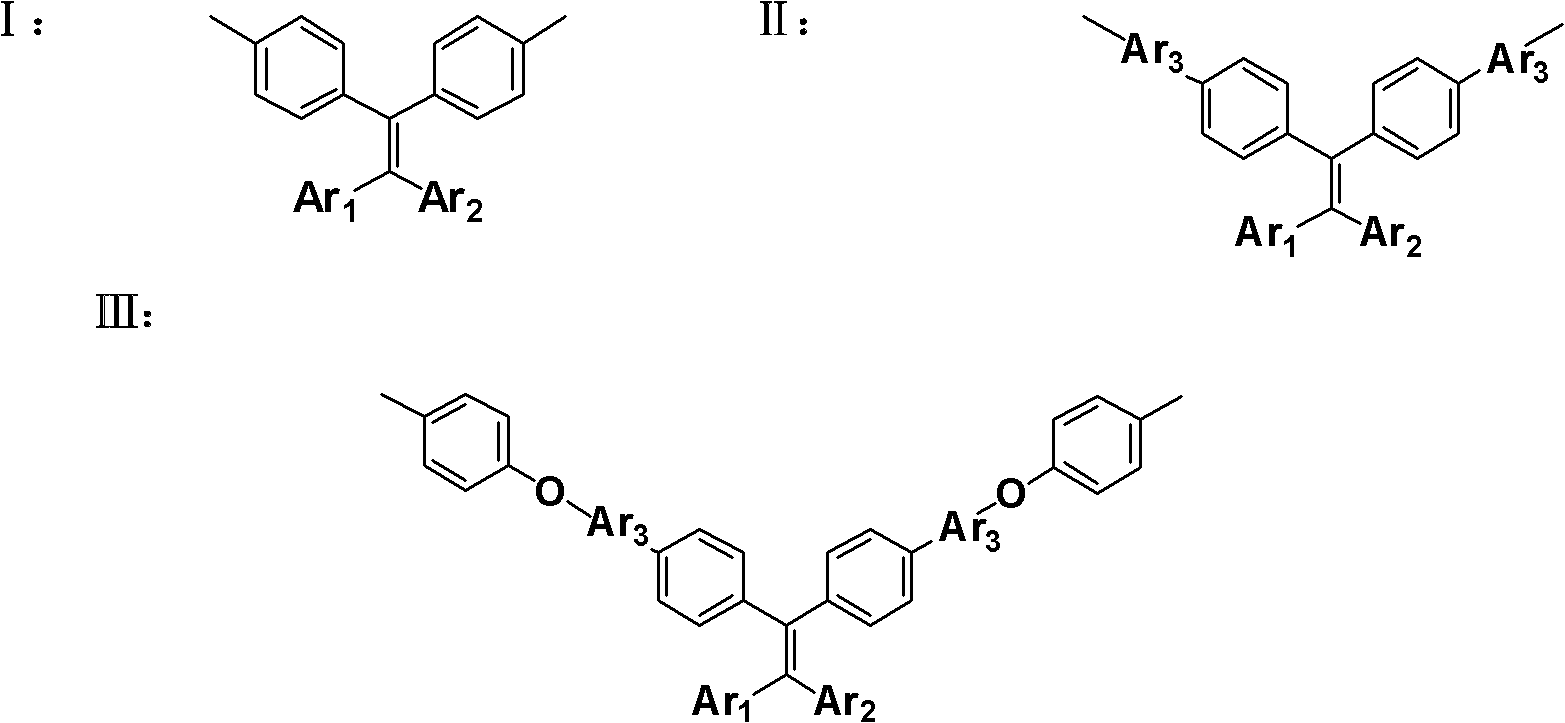Soluble functional polyimide containing rigid non-planar conjugated structure, and preparation method and application thereof
A polyimide, conjugated structure technology, applied in the field of material science, can solve problems such as single species, achieve the effects of simple preparation process, excellent photoluminescence, high glass transition temperature and thermal stability
- Summary
- Abstract
- Description
- Claims
- Application Information
AI Technical Summary
Problems solved by technology
Method used
Image
Examples
Embodiment 1
[0040] At room temperature, 4.3856g (0.01mol) 4', 4"-(2-phenylethene-1,1-diyl) dibiphenyl-4-amine (TriPEDBA) and 58.6g (62.3ml) N, N-dimethyl form Add the amide into a 100ml three-necked flask, pass in argon, stir, and after it is completely dissolved, add 4.4424g (0.01mol) of 4,4-hexafluoroisopropylphthalic anhydride (6-FDA), and continue to stir the reaction After 4 hours, a homogeneous, transparent and viscous polyamic acid solution was obtained. Scrape-coat the obtained polyamic acid solution on a clean glass plate, then place the glass plate in a vacuum oven, vacuumize, and the heating program is: room temperature to 100°C After constant temperature (the whole process 1h) → 100°C to 200°C, then constant temperature (the whole process 1h) → 200°C to 350°C, then constant temperature (the whole process 1.5h), the polyimide film can be taken out after cooling. The 5% thermal weight loss temperature of the imide film is 524°C, the glass transition temperature is 361°C, the str...
Embodiment 2
[0044] Prepare polyamic acid solution in the same way as in Example 1, and then prepare polyimide by chemical imidization. The steps are as follows: add 5 mL of acetic anhydride to the obtained polyamic acid solution, continue stirring, and then slowly add 2.5 mL of three Ethylamine, and heated to 70°C, continued to stir for 6 hours, then scraped the solution onto a clean glass plate, then placed the glass plate in a vacuum oven, evacuated, and dried at 100°C for 12 hours, and the polyimide film could be taken out after cooling. The 5% thermal weight loss temperature of the polyimide film is 527°C, the glass transition temperature is 363°C, the wavelength corresponding to the strongest fluorescence peak is 462nm, the visible light transmittance is 85%, the solubility of the polyimide film is Test result and infrared spectrogram are identical with embodiment 1.
Embodiment 3
[0046] At room temperature, 4.3856g (0.01mol) 4', 4"-(2-phenylethene-1,1-diyl) dibiphenyl-4-amine (TriPEDBA) and 48.6g (51.5ml) N, N-dimethyl form Add the amide into a 100ml three-necked flask, pass in argon, stir, and after it is completely dissolved, add 2.9027g (0.01mol) of 4,4'-biphenyltetracarboxylic dianhydride (BPDA), and continue stirring for 2h to obtain a homogeneous Transparent and viscous polyamic acid solution. Scrape-coat the obtained polyamic acid solution on a clean glass plate, then place the glass plate in a vacuum oven and vacuumize it. 1h) → 100°C to 200°C and then constant temperature (the whole process 1h) → 200°C to 350°C and then constant temperature (the whole process 1.5h), the polyimide film can be taken out after cooling. The polyimide film 5 The thermal weight loss temperature of % is 551°C, the glass transition temperature is 368°C, the wavelength corresponding to the strongest fluorescence peak is 467nm, and the visible light transmittance is 88%...
PUM
| Property | Measurement | Unit |
|---|---|---|
| temperature | aaaaa | aaaaa |
| glass transition temperature | aaaaa | aaaaa |
| temperature | aaaaa | aaaaa |
Abstract
Description
Claims
Application Information
 Login to View More
Login to View More - R&D
- Intellectual Property
- Life Sciences
- Materials
- Tech Scout
- Unparalleled Data Quality
- Higher Quality Content
- 60% Fewer Hallucinations
Browse by: Latest US Patents, China's latest patents, Technical Efficacy Thesaurus, Application Domain, Technology Topic, Popular Technical Reports.
© 2025 PatSnap. All rights reserved.Legal|Privacy policy|Modern Slavery Act Transparency Statement|Sitemap|About US| Contact US: help@patsnap.com



